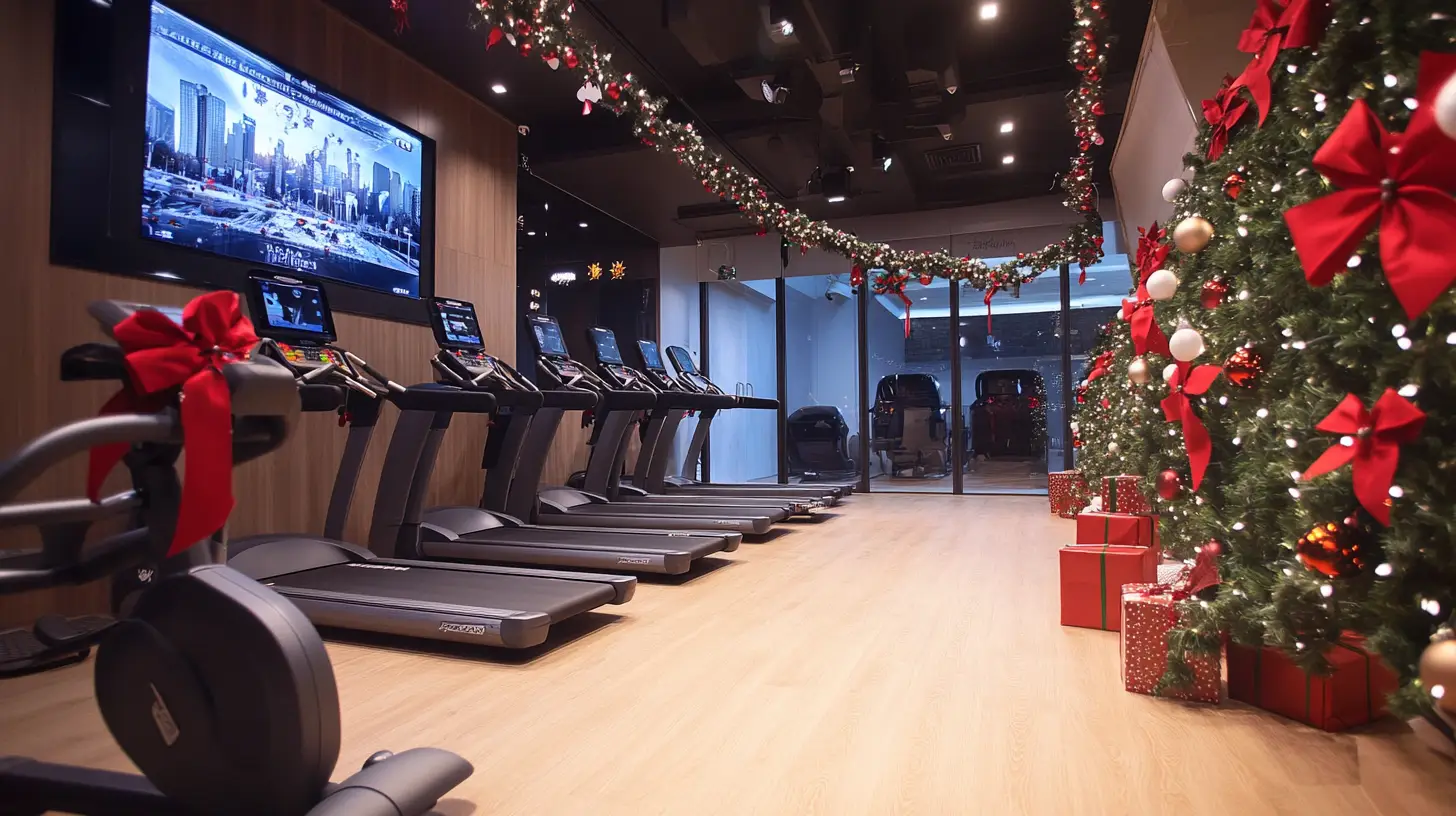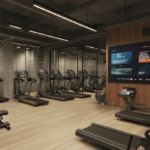Using health progress screens at your fitness center is essential for optimizing your fitness journey. Start with a baseline fitness check to establish where you stand. With advanced assessments, you can create personalized fitness scores and track improvements. Regular re-testing and careful monitoring guarantee you stay on track. Don't forget to use fitness apps and smart gym equipment to provide real-time coaching and detailed progress monitoring. Tracking key metrics like body composition helps in adjusting your workout, diet, and lifestyle for better results. Understand the benefits such data offers for achieving your goals and discover more on how to get the most out of your workouts.
Table of Contents
ToggleKey Takeaways
- Conducting safety checks ensures a secure workout environment and reduces the risk of injuries.
- Establishing baseline fitness provides a starting point to measure progress and set realistic goals.
- Advanced fitness assessments offer detailed insights into various fitness aspects, helping tailor personalized workout plans.
- Tracking small changes in fitness metrics helps maintain motivation and highlights continuous improvement.
- Re-testing and monitoring allow for adjustments in workout routines to enhance effectiveness and achieve fitness goals.
Before You Begin at the Gym
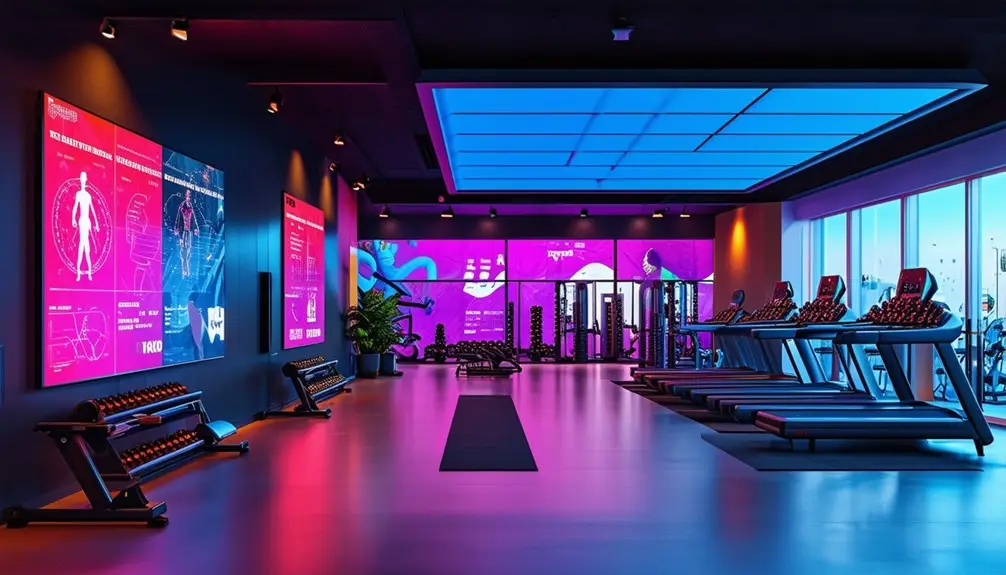
Before you step into the gym, make sure you've completed a thorough safety check to guarantee a secure workout environment. This initial step is essential for protecting your health and ensuring steady fitness progress. Pay attention to the equipment around you, making sure everything is in proper working order and free from potential hazards. This proactive measure sets the stage for a productive session.
One essential aspect of preparing for the gym is understanding your current health status. Prior to diving into any workout routine, take the time to measure your resting heart rate. This simple metric is a powerful indicator of your cardiovascular fitness and overall health. A lower resting heart rate generally signifies a more efficient heart function and higher fitness levels. Monitoring this can help you gauge progress over time.
Additionally, filling out a health questionnaire can provide valuable insights into your well-being. This information helps trainers tailor exercise programs that meet your specific needs and abilities. By addressing any pre-existing conditions or concerns, you can create a safer and more effective workout plan.
Basic Baseline Fitness Check

A basic starting point fitness check is your first step to creating a personalized and effective workout plan. By beginning with a health questionnaire, you'll provide important health information that helps identify any pre-existing conditions or risk factors. Next, measuring your resting heart rate and blood pressure offers insight into your cardiovascular health, establishing a clear starting point for your fitness journey.
This starting point fitness check is essential for designing a fitness program tailored to your unique needs and goals. Knowing where you stand allows you to set realistic, achievable objectives, ensuring your fitness plan is both safe and effective. By recording all this starting point fitness information, you can engage in progress tracking, which is crucial for staying motivated and on course.
Regularly re-testing these basic fitness parameters lets you monitor improvements and make necessary adjustments to your fitness program. Each re-assessment provides updated health information, allowing you to refine your routine and continue progressing. Without a solid starting point, it's challenging to measure success or identify areas needing improvement. Make sure to commit to these checks and use the insights gained to optimize your fitness journey.
Advanced Fitness Check
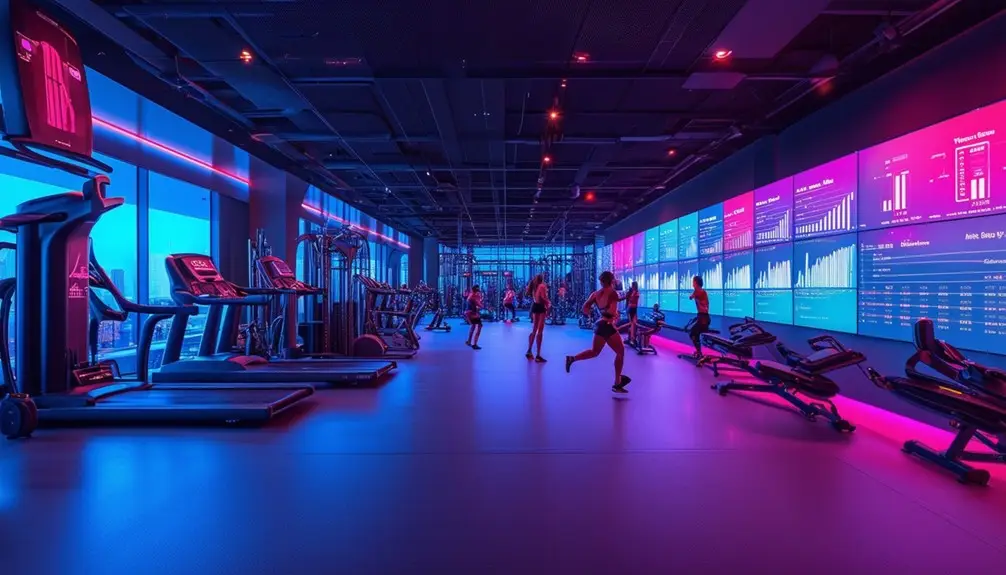
Building on your initial fitness evaluation, an advanced fitness examination delves deeper into your physical capabilities to fine-tune your workout plan. This thorough assessment includes flexibility assessments, cardiovascular assessments, and strength assessments, providing you with a detailed picture of your fitness levels. By incorporating advanced testing methods, you can gather accurate data about your physical condition, helping you customize a personalized fitness program to address specific areas of improvement.
Here's what an advanced fitness examination might include:
- Flexibility Assessments: Evaluate your range of motion to identify restricted areas that might hinder your performance.
- Cardiovascular Assessments: Monitor your heart rate and endurance to assess your cardiovascular well-being.
- Strength Assessments: Analyze your muscle strength and endurance to inform your Strength Training routine.
Specialized equipment and trained professionals ensure the precision and dependability of these assessments. By tracking your fitness with regular advanced examinations, you can monitor progress over time and pinpoint areas requiring focused training. This approach not only optimizes your workout plan but also helps prevent injuries by addressing weaknesses and imbalances. Embrace the journey; each step forward is a confirmation of your dedication to improving your fitness levels.
Establishing Fitness Scores
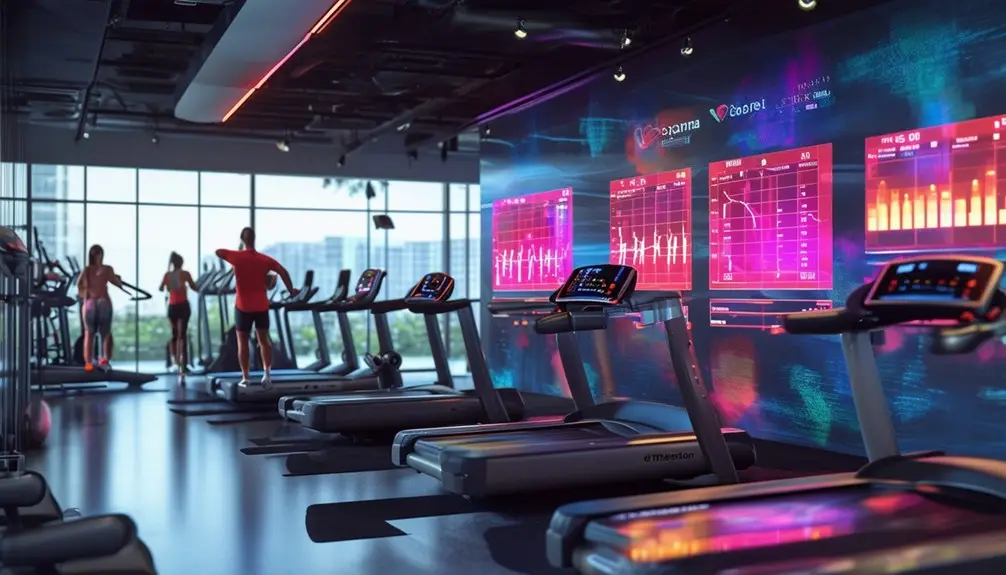
To effectively track your fitness journey, establishing fitness scores through baseline assessments is necessary. These initial assessments, which include flexibility tests, cardiovascular evaluations, and strength measurements, provide a thorough starting point for your training. By understanding your current fitness levels, you can set realistic, achievable fitness goals tailored to your needs.
Tracking progress is a vital aspect of any fitness regimen. Your baseline fitness scores act as benchmarks, helping you monitor improvements over time. Regular re-testing allows you to see how your body responds to different workouts and training programs. This process not only highlights your progress but also keeps you motivated by showcasing tangible results.
Monitoring progress through these scores enables you to make informed adjustments to your workout plans. If you notice significant gains in strength but lagging cardiovascular performance, you can tweak your training to address these areas. This continuous cycle of assessment and adjustment ensures that you're always moving towards your fitness goals efficiently.
In essence, fitness scores provide a clear, measurable way to track your fitness journey. They offer the feedback you need to stay committed and make data-based decisions that enhance your overall health and fitness.
Comparing Fitness Scores

Evaluating your progress through comparing fitness scores empowers you to identify strengths, address weaknesses, and make informed adjustments to your training regimen. By analyzing your baseline assessments against your current performance metrics, you're able to track progress effectively across several key areas: cardiovascular fitness, strength, and flexibility. This ongoing analysis is vital for achieving goals and maintaining motivation.
Monitoring progress becomes simpler and more effective when you regularly compare your fitness scores. Here's how it helps:
- Identify Strengths: Knowing where you excel allows you to build on those areas and maximize your potential.
- Address Weaknesses: Pinpointing weaker areas gives you the opportunity to focus on them, ensuring a balanced and thorough fitness routine.
- Make Informed Adjustments: Adjusting your workout routines based on your scores ensures that each session is tailored for best results.
Re-Testing and Monitoring

Regularly re-testing your fitness levels is crucial for accurately monitoring your progress and making necessary adjustments to your workout routines. By periodically re-assessing your fitness, you can effectively track your progress and see where you've made significant fitness improvements. This kind of progress tracking isn't just motivational; it's also critical for guaranteeing your workouts remain effective and aligned with your evolving fitness goals.
Re-testing provides concrete data on various aspects of your health, including cardiovascular endurance, muscle strength, and flexibility. These repeat assessments allow you to compare your current performance with your initial baseline, giving you a clear picture of how far you've come.
Seeing tangible improvements through re-testing can be incredibly motivating. It validates your hard work and encourages you to push forward. But more importantly, regular monitoring is crucial for setting new goals. As you achieve your initial targets, you'll need to re-evaluate and set new ones to continue progressing. This cycle of assessment, adjustment, and goal-setting ensures you're always moving toward optimal health outcomes.
Other Progress Checking Methods

Tracking your fitness journey through various progress checking methods can greatly enhance your workout effectiveness and keep you motivated. There are numerous ways to keep track of your progress and optimize your training program is on the right path.
One effective method is using workout journals. By recording details like workout specifics, sets, reps, and weights used, you can monitor your progress and make necessary adjustments to your training program. This traditional method provides a clear visual representation of your fitness journey.
Another invaluable tool is pulse monitors. These devices offer real-time feedback on your exercise intensity, helping you stay within your best heart rate zone. This not only aids in achieving your fitness goals more efficiently but also ensures you're not overexerting yourself.
Most modern gym equipment comes with integrated computer monitoring systems. These track metrics such as distance, speed, and calories burned, allowing you to monitor your progress right on the machine. This real-time data can be essential in adjusting your training program to better meet your fitness goals.
- Workout journals
- Pulse monitors
- Integrated computer monitoring systems
Choose the method that aligns best with your goals, and you'll stay motivated and on track throughout your fitness journey.
Benefits of Data Tracking

By consistently tracking your fitness data, you'll stay motivated and accountable, making it easier to see even the smallest improvements. This focus on incremental changes keeps you engaged and driven. Plus, clear performance metrics help you maintain a goal-oriented approach, ensuring you're always moving forward.
Motivation and Accountability
Embracing data tracking in your fitness routine can shift your focus from weight loss to overall health improvements, keeping you motivated and accountable. By paying attention to metrics like body composition and performance-based goals, you can see your fitness journey in a whole new light. Using fitness trackers allows you to track your progress accurately, giving you clear insights into your improvements and helping you stay committed to achieving your goals.
With data tracking, you'll notice small victories that might otherwise go unseen. These incremental changes can provide a steady stream of motivation, ensuring you remain dedicated to your fitness plan. Accountability is another significant benefit; when you regularly monitor your fitness data, you're more likely to stick to your routine and make informed decisions about your health.
- Resting heart rate: Tracking this can reveal how your cardiovascular health improves over time.
- Body fat percentage: Observing changes in body composition can be more motivating than just watching the scale.
- Performance metrics: Keeping tabs on your endurance and strength gains can drive you to reach new heights.
Data tracking transforms your fitness journey into a detailed, motivating, and accountable experience, making it easier to stay on track and reach your fitness aspirations.
Track Small Changes
Focusing on small changes in your fitness data can shift your mindset from short-term weight loss to long-term health and performance improvements. By zeroing in on metrics like body fat percentage, muscle mass, and daily step count, you can see tangible progress that goes beyond the scale. Instead of getting frustrated over slow weight loss, you'll find motivation in watching your muscle mass increase or your body fat percentage decrease.
Tracking these small changes can keep you engaged in your fitness routine. When you monitor your daily step count, for instance, you can aim to gradually increase it, fostering a more active lifestyle. Observing these incremental improvements not only boosts your morale but also holds you accountable. You'll be more likely to stick to your fitness routine when you see real, measurable progress.
Moreover, celebrating these small victories can lead to long-term success. Whether it's shaving a few seconds off your running time or increasing your lifting weights slightly, these achievements accumulate, making a significant impact on your overall health and fitness. So, embrace the power of data tracking and let it guide you toward lasting improvements in your fitness journey.
Goal-Oriented Focus
Tracking your fitness data empowers you to set and achieve specific health goals, transforming your approach from weight loss to overall wellness. By using a fitness tracker, you can monitor key metrics that provide a clearer picture of your health and fitness, helping you stay motivated and responsible.
Focusing on performance-based goals like endurance, strength, and speed can be more beneficial than solely aiming for aesthetic changes. Regularly tracking your progress keeps you engaged and provides tangible proof of improvement, which is essential for maintaining motivation. Here are some key benefits of data tracking:
- Responsibility: Tracking progress makes it easier to stay committed to your goals by providing regular feedback on your efforts.
- Inspiration: Observing small changes in metrics like resting heart rate and body fat percentage can keep you motivated to continue.
- Holistic Health: Shifting focus from just weight loss to overall wellness helps you achieve a balanced, sustainable fitness journey.
Using a fitness tracker to measure various health indicators ensures you're moving in the right direction. It's not just about the numbers; it's about understanding your body and making informed decisions to enhance your overall well-being.
Key Metrics to Track

When you're tracking your health progress at the fitness center, start by focusing on key metrics like resting heart rate and body composition analysis. Monitoring these can give you essential insights into your cardiovascular health and physical makeup. By consistently checking these numbers, you'll be well-equipped to make informed decisions about your fitness journey.
Resting Heart Rate
Your resting heart rate is a key metric that provides valuable insights into your cardiovascular fitness and overall health. Knowing your resting heart rate can help you monitor your overall fitness progress and make informed decisions about your exercise routine. Typically, a lower resting heart rate indicates better cardiovascular fitness, as your heart becomes more efficient at pumping blood with regular exercise.
Monitoring your resting heart rate allows you to track changes over time, which can highlight improvements in your fitness or signal potential health concerns. To get the most out of this metric, consider the following:
- Consistency: Measure your resting heart rate at the same time each day, preferably in the morning before you get out of bed.
- Accuracy: Use a reliable device, such as a heart rate monitor or fitness tracker, to ensure accurate readings.
- Trends: Look for long-term trends rather than daily fluctuations. A consistently elevated resting heart rate might indicate overtraining or other health issues.
Body Composition Analysis
Understanding your body's composition is vital for setting effective fitness goals and tracking your progress accurately. Body composition analysis measures the percentages of body fat, muscle, water, and bone mass, offering a detailed look at your overall health. By focusing on key metrics like body fat percentage, muscle mass, visceral fat levels, and overall weight distribution, you can set realistic goals and make informed decisions about your exercise and nutrition plans.
Using advanced tools like a smart scale can provide you with detailed insights into these metrics. Many smart scales utilize bioelectrical impedance analysis (BIA), which sends a small electrical current through your body to estimate your body composition. For even more precise tracking, consider DEXA scans, which offer detailed imaging of your body's composition.
Tracking these changes over time is essential. Fitness apps can help you monitor your metrics and make necessary adjustments to your workout routine, diet, and lifestyle. By integrating body composition analysis into your fitness journey, you'll be better equipped to achieve your goals and enhance your overall health. Remember, the numbers on the scale are just part of the story—understanding the full picture is what truly drives progress.
Smart Home Gym Equipment
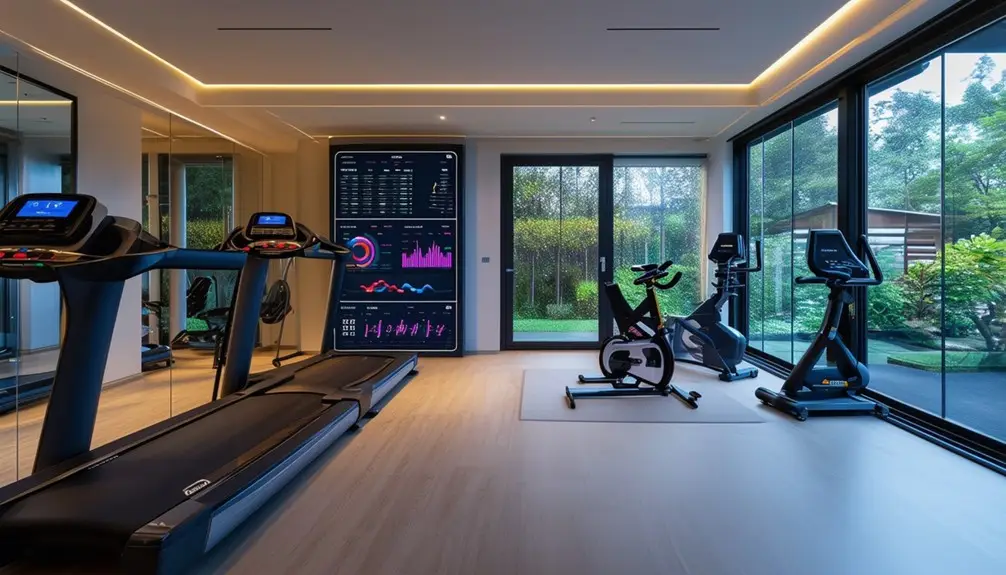
Investing in smart home gym equipment like Peloton Tread or NordicTrack RW900 can revolutionize your fitness routine with cutting-edge technology and real-time coaching. These devices not only enhance your workouts but also provide detailed tracking to keep you motivated and informed. By incorporating bodyweight exercises and tracking calories burned, these machines help you maintain an accurate record of your workouts, essential for anyone serious about their fitness and health.
High-end smart fitness machines come with features that elevate your home workouts to a professional level. For instance, Peloton Tread offers internet connectivity for streaming a variety of classes, while NordicTrack RW900 delivers trainer-led rowing workouts. The subscription fees, typically ranging between $29 to $39 per month, grant you access to a plethora of engaging and effective fitness routines.
- Tempo Studio and Tonal: These machines offer virtual personal trainers and intelligent strength-training features.
- FightCamp: This connected home boxing gym tracks punches in real-time, making your workouts immersive and engaging.
- Peloton Tread: Besides running, it supports a wide range of exercises, making it versatile for different fitness goals.
Incorporating smart home gym equipment into your routine can keep you on track and motivated, making your fitness journey both efficient and enjoyable.
Frequently Asked Questions
How Can You Monitor Progress of Your Fitness Program?
You can monitor your fitness progress by tracking key metrics like heart rate, step count, body fat, and muscle mass. Use fitness trackers, keep a journal, and celebrate your achievements to stay motivated and adjust your routine.
How to Keep Track of Gym Progress?
Imagine sculpting a masterpiece—your body. Keep track of gym progress by recording fitness data, using wearable trackers, and snapping progress photos. Measure body metrics, monitor strength and endurance, and celebrate achievements to stay motivated.
How Do You Know if You Are Progressing in the Gym?
You know you're progressing in the gym by monitoring your resting heart rate, tracking blood pressure changes, comparing initial and current fitness scores, and re-testing periodically to adjust workout routines and celebrate achievements. Keep pushing forward!
What Are the Two Methods of Monitoring Clients Progress During Exercise?
You can monitor your clients' progress using two methods: tracking fitness data and utilizing fitness assessments. By combining these, you'll gain valuable insights and be able to make informed adjustments to their routines and goals.
Conclusion
Just like a GPS guides you on a road trip, fitness progress screens can navigate your journey to better health. By tracking key metrics and comparing your fitness scores, you'll gain a clear picture of your progress and areas for improvement. Embrace this data-driven approach to maximize your workouts and achieve your fitness goals. Remember, with the right tools and a committed mindset, you can transform your fitness dreams into reality. Keep pushing forward!
